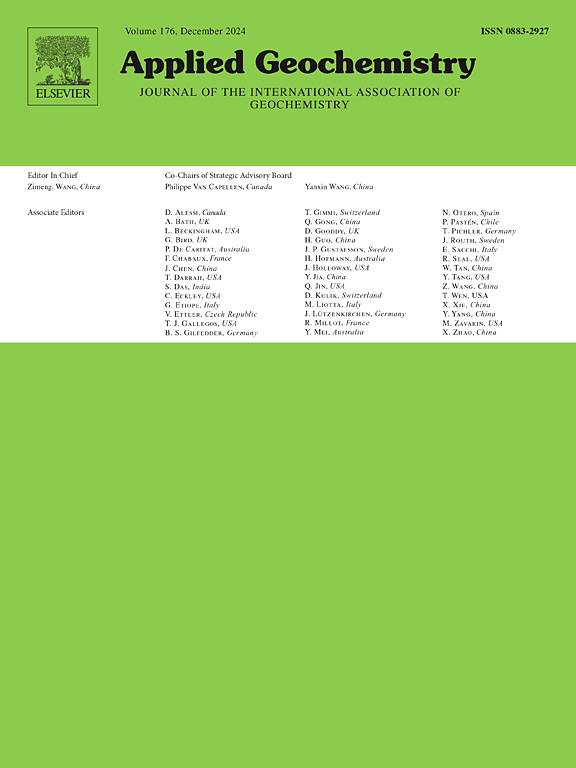阿富汗赫尔曼德盆地的锂资源测绘:使用层次分析法的多标准分区方法
IF 3.4
3区 地球科学
Q1 GEOCHEMISTRY & GEOPHYSICS
引用次数: 0
摘要
赫尔曼德盆地横跨阿富汗南部、伊朗和巴基斯坦的部分地区,是一个极度干旱的内陆地区,锂盐(Li-brine)储量潜力巨大。虽然锂在自然界中是主要来源(例如,花岗岩伟晶岩类型),也是地下盐湖或古盐湖沉积的次要来源,但目前仍缺乏采用基于优先级的锂勘探政策的通用方法。本研究采用启发式方法,具体探讨了Helmand盆地的构造复杂性、气候和地质条件,使其成为锂盐勘探的一个有希望的目标。利用层次分析法(AHP),通过参数化热液活动、富锂岩性、地壳厚度、干旱气候和构造沉降等关键因素,系统地识别了潜在的锂源和富集带。本研究建立的空间区划模型预测了锂盐系统的不同概率区域,并强调东北盆地是最有希望的锂源。确定了特定的补给和运输路径,绘制了Li从源区到高海拔湖泊的迁移图,包括Ab-e Istada和dash -e Nawar。此外,Godzareh凹陷成为一个重要的锂盐聚集地,受益于整个盆地的区域补给。该研究证明了AHP在整合复杂地理空间数据以进行精确的锂盐勘探方面的实用性。研究结果为指导经济上可行的锂资源开发提供了战略框架,将赫尔曼德盆地定位为全球锂盐供应的关键贡献者。本文章由计算机程序翻译,如有差异,请以英文原文为准。

Lithium resource mapping in Afghanistan's Helmand Basin: A multi-criteria approach of zonation using the Analytic Hierarchy Process
The Helmand Basin, which spans southern Afghanistan and parts of Iran and Pakistan, is a hyperarid, endorheic region with a high potential for lithium-brine (Li-brine) deposits. Although lithium is available in nature as a primary source (for instance, granite pegmatite type) and as a secondary source of deposition in salt lakes or palaeo-salars in the subsurface, a generalised methodology for adopting a priority-based lithium exploration policy is still absent. This study, driven by a heuristic approach, specifically explores the Helmand basin's tectonic complexity, as well as its climatic and geological conditions, which make it a promising target for Li-brine exploration. By utilising the Analytic Hierarchy Process (AHP), we systematically identified potential Li-source and accumulation zones by parameterising key factors such as hydrothermal activity, Li-rich lithology, crustal thickness, arid climate, and tectonic subsidence. The spatial zonation model developed in this study predicts areas with varying probabilities for Li-brine systems, highlighting the northeastern basin as the most promising for Li sources. Specific recharge and transport pathways were identified, mapping Li migration from source zones to high-elevation lakes, including Ab-e Istada and Dasht-e Nawar. Additionally, the Godzareh Depression emerged as a significant Li-brine accumulation site, benefiting from regional recharge throughout the entire basin. This study demonstrates the utility of AHP in integrating complex geospatial data for precise Li-brine exploration. The results provide a strategic framework for guiding economically viable lithium resource development, positioning the Helmand Basin as a key contributor to the global Li-brine supply.
求助全文
通过发布文献求助,成功后即可免费获取论文全文。
去求助
来源期刊

Applied Geochemistry
地学-地球化学与地球物理
CiteScore
6.10
自引率
8.80%
发文量
272
审稿时长
65 days
期刊介绍:
Applied Geochemistry is an international journal devoted to publication of original research papers, rapid research communications and selected review papers in geochemistry and urban geochemistry which have some practical application to an aspect of human endeavour, such as the preservation of the environment, health, waste disposal and the search for resources. Papers on applications of inorganic, organic and isotope geochemistry and geochemical processes are therefore welcome provided they meet the main criterion. Spatial and temporal monitoring case studies are only of interest to our international readership if they present new ideas of broad application.
Topics covered include: (1) Environmental geochemistry (including natural and anthropogenic aspects, and protection and remediation strategies); (2) Hydrogeochemistry (surface and groundwater); (3) Medical (urban) geochemistry; (4) The search for energy resources (in particular unconventional oil and gas or emerging metal resources); (5) Energy exploitation (in particular geothermal energy and CCS); (6) Upgrading of energy and mineral resources where there is a direct geochemical application; and (7) Waste disposal, including nuclear waste disposal.
 求助内容:
求助内容: 应助结果提醒方式:
应助结果提醒方式:


